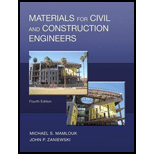
Concept explainers
A project specifies a concrete strength of at least 3000 psi. Materials engineers will design the mix for a strength higher than that. Calculate the required average compressive strength of the mix design if the standard deviation is s = 350 psi. Estimate the modulus of elasticity of the concrete at the required average compressive strength (the calculated strength, not the given strength).
Learn your wayIncludes step-by-step video

Chapter 7 Solutions
Materials for Civil and Construction Engineers (4th Edition)
Additional Engineering Textbook Solutions
Foundation Design: Principles and Practices (3rd Edition)
Mechanics of Materials (10th Edition)
Starting Out with Java: From Control Structures through Data Structures (3rd Edition)
Artificial Intelligence: A Modern Approach
Starting Out with C++: Early Objects (9th Edition)
Starting out with Visual C# (4th Edition)
- If you knew that the cubic compressive strength of a certain type of concrete is 35 MPa, then calculate the resulting load during the examination, the maximum force applied by the test device)? 1- Fission tensile test 2- Fault modulus test 3- Compressive test for cylinderarrow_forwardWhat is the maximum aggregate size that can be used in concrete for the following conditions:arrow_forwardIn compressive strength testing of concrete, which type of concrete will give a more accurate result. 100mm by 100mm cubed concrete or 100mm cylinder concrete. Why?arrow_forward
- A concrete mix includes the following ingredients per cubic meter: Cement%3D400 kg Water=184 kg No admixture Table below shows possible alternatives mix ingredients. Indicate in the appropriate boxes in the table what will happen in each case for the workability and the ultimate compressive strength as increase, decrease or approximately the same. What will happen? Cement Water Admixture (kg) (kg) Ultimate compressive Workability strength 400 225 None 449 184 None Water 400 184 Reducer Water 400 128 Reducer 400 184 Super Plasticizer 400 184 Air Entrainer 400 184 Accelerator DFocusarrow_forwardA. What are the primary and secondary parameters upon which durability of concrete depends on? Discuss in detail one PRIMARY PARAMETER to which concrete is exposed in the image shown: *arrow_forward6. Discuss the different types of volume change in concrete at early and long-term ages.arrow_forward
- A concrete mix includes the following ingredients per cubic meter: a. Cement = 400 kg b. Water = 176 kg c. No admixture Table P6.30 shows possible changes that can be made to the mix ingredi- ents. Indicate in the appropriate boxes in the table what will happen in each case for the workability and the ultimate compressive strength as increase, decrease, or approximately the same.arrow_forward4b. Deformation occurs on freshly lay concrete when it finally set or harden.discuss the various causes for dimensional changes in the hardened concrete.arrow_forwardConcrete is required for a column that will be Severe exposed to freezing and thawing. The cross section of the column is 300 × 300 mm. The smallest spacing between reinforcing steel is 30 mm. The Required Average Compressive Strength of concrete at 28 days is 35 MPa with a slump of 80 to 100 mm. The properties of materials are as follows: ❖ Cement used is type I Portland cement with a specific gravity of 3.15. ◆ The available coarse aggregate has a maximum size of 23 mm, a dry-rodded unit weight of 1800 kg/m3, a bulk specific gravity (SSD) of 2.7, absorption capacity of 0.55%, and moisture content (SSD) of 0.25%. The fine aggregate has a bulk specific gravity (SSD) of 2.75, absorption capacity of 1.4%, a moisture content (SSD) of 2.5%, and a fineness modulus of 2.70. The aggregates conform to the ASTM C33-84 requirements for grading.arrow_forward
- Q3: B: Design the concrete mix according to the following conditions: Design Environment Building frame Required design strength = 27.6 MPa Minimum dimension = 150 mm Minimum space between rebar = 40 mm Minimum cover over rebar = 40 mm Statistical data indicate a standard deviation of compressive strength of 2.1 MPa is expected (more than 30 samples). Only air entrainer is allowed. Available Materials Air entrainer: Manufacture specification 6.3 ml/1% air/100 kg cement. Coarse aggregate: 19 mm nominal maximum size, river gravel (rounded) Bulk oven-dry specific gravity = 2.55, absorption = 3.6, Oven-dry rodded density = 1761 kg/m3 %3D Moisture content = 2.5, Fine aggregate: Natural sand Bulk oven-dry specific gravity 2.659, absorption=0.5, Moisture content = 2, Fineness modulus = 2.47arrow_forwardConcrete is required for a column that will be Severe Exposure to freezing and thawing. The cross section of the column is 300 × 300 mm. The smallest spacing between reinforcing steel is 40 mm. The specified compressive strength of concrete at 28 days is 40 MPa with a slump of 25 to 50 mm. The properties of materials are as follows: (a) Cement used is type I Portland cement with a specific gravity of 3.10. (b) The available coarse aggregate has a maximum size of 23 mm, a dry-rodded unit weight of 1800 kg/m3, a bulk specific gravity (SSD) of 2.68, absorption capacity of 0.65%, and moisture content (SSD) of 0.27%. (c) The fine aggregate has a bulk specific gravity (SSD) of 2.75, absorption capacity of 1.5%, a moisture content (SSD) of 2.5%, and a fineness modulus of 2.7,The aggregates conform to the ASTM C33-84 requirements for grading.arrow_forwardChapter 13 Question: What is the elasticity of concrete for a normal weight mix (unit weight equal to 150 pcf) with a compressive strength of 5,000 psi? O 3.644 ksi O 4.074 ksi 4,287 ksi O 3.976 ksi O 3,834 ksiarrow_forward

 Structural Analysis (10th Edition)Civil EngineeringISBN:9780134610672Author:Russell C. HibbelerPublisher:PEARSON
Structural Analysis (10th Edition)Civil EngineeringISBN:9780134610672Author:Russell C. HibbelerPublisher:PEARSON Principles of Foundation Engineering (MindTap Cou...Civil EngineeringISBN:9781337705028Author:Braja M. Das, Nagaratnam SivakuganPublisher:Cengage Learning
Principles of Foundation Engineering (MindTap Cou...Civil EngineeringISBN:9781337705028Author:Braja M. Das, Nagaratnam SivakuganPublisher:Cengage Learning Fundamentals of Structural AnalysisCivil EngineeringISBN:9780073398006Author:Kenneth M. Leet Emeritus, Chia-Ming Uang, Joel LanningPublisher:McGraw-Hill Education
Fundamentals of Structural AnalysisCivil EngineeringISBN:9780073398006Author:Kenneth M. Leet Emeritus, Chia-Ming Uang, Joel LanningPublisher:McGraw-Hill Education
 Traffic and Highway EngineeringCivil EngineeringISBN:9781305156241Author:Garber, Nicholas J.Publisher:Cengage Learning
Traffic and Highway EngineeringCivil EngineeringISBN:9781305156241Author:Garber, Nicholas J.Publisher:Cengage Learning





